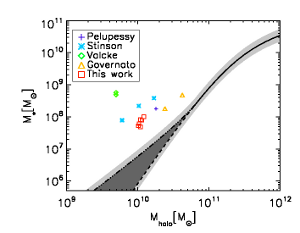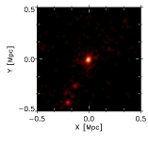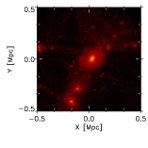|
|  |
Visible matter - stars, planets and interstellar gas - accounts for
only about five percent of the matter content in the
Universe. Everything that remains is invisible: about three quarters
Dark Energy and just under one quarter of Dark Matter, identified only
through its gravitational pull. A direct detection of Dark Matter is
still outstanding, its properties, however, are crucial to the
formation of structure in the Universe. They predict how haloes of
Dark Matter form - Galaxies evolve inside these Dark Matter haloes -
and how the haloes are distributed in the Universe. The process of
cosmic structure formation has been studied at the MPA with the
 Millennium simulations
in unprecedented accuracy.
Millennium simulations
in unprecedented accuracy.
A comparison of these kinds of simulations with observations of large
numbers of galaxies gives the scientists clues about how the formation
of galaxies and haloes are linked. Assuming that larger galaxies form
in larger haloes, one can deduce a statistical relation between
visible and invisible matter in galaxies with different mass. To
understand the evolution of individual galaxies in detail, simulations
with much higher resolution are needed, where visible and dark matter
can interact directly. In addition to gravitation many other physical
processes have to be taken into account, such as the gas
hydrodynamics, the thermal evolution of the interstellar and
intergalactic medium, star formation and evolution and the effects of
cosmic UV-radiation.
In their now published work, Till Sawala an his co-authors selected
six Dark Matter haloes with different formation histories from the
Millenium-II simulation and carried out new simulations with 100 times
higher resolution. All six haloes grow to a mass of some 100 billion
solar masses, which corresponds to galaxies of about one million solar
masses in stars according to the statistical relation. The detailed
simulations however yielded star masses between 50 and 100 million
solar masses ? orders of magnitude more than the expected amount.
These results agree indeed with previous similar simulations of
individual dwarf galaxies. The representative selection of the haloes
enabled the team around Till Sawala to show now that the much larger
mass in stars is not due to peculiarities of the galaxies
simulated. It does in fact represent a disagreement between the
current simulations and observations.
"Three explanations could resolve this discrepancy", Till Sawala
comments. "The observational picture could be incomplete, which would
mean that there are many more dwarf galaxies than we believe at the
moment. Alternatively, the abundance of Dark Matter haloes could be
different from predictions of the so-called standard model of Cold
Dark Matter. If both the dwarf galaxy count and the Cold Dark Matter
model are correct, then we would have to conclude that all simulations
over-predict the real star formation rates in dwarf galaxies by at
least a factor of 10."
All three potential solutions would entail far-reaching consequences:
"We think that the current observational counts of galaxies are
sufficiently complete and that we have a fairly good understanding of
the remaining incompleteness," explains co-author Qi Guo of the
University of Durham. "A difference by a factor of four would also
affect other models, which rely on these results."
To test the second hypothesis, i.e. an alternative to the established
Cold Dark Matter model, the authors compare the distribution of haloes
with simulations of Warm Dark Matter. Since in this model less
structure forms on small scales, it appears to bring the abundance of
simulated galaxies in agreement with observations. Professor Simon
White, however, is sceptical: "Such a model is in conflict with other
observations which makes this explanation very unlikely."
If both the observed count of dwarf galaxies is complete, and the
distribution of Dark Matter follows the predictions, the remaining
option is for the simulations to be wrong about the efficiency with
which stars are formed. Since all current simulations reach similar
results with slightly different methods, this does not seem to be due
to some numerical error. A more likely explanation is that some
important process, responsible for inhibiting star formation in real
galaxies, has so far been missing from the simulations.
"Only one thing is certain: The current observations of dwarf
galaxies, the assumptions of how they populate dark matter haloes, and
the current simulations of galaxy formation cannot all be correct at
the same time", summarizes Till Sawala. The authors agree: "The study
of galaxy evolution will continue to surprise us for some time to
come."
Till Sawala
|




